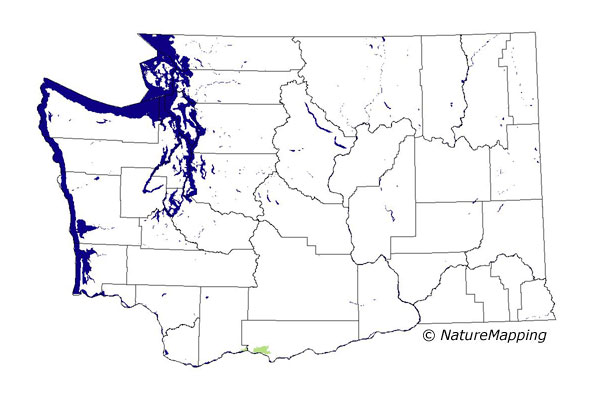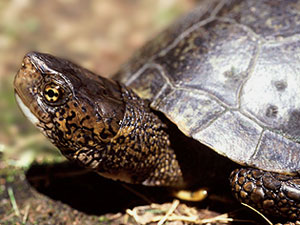


Western Pond Turtle (Clemmys marmorata) What they look like: The coloration of the western pond turtle ranges from brown to black on the carapace (the upper shell), with lighter marbling visible close up. The plastron (the lower shell) is black and yellow. The head and legs are dark with possible yellow markings (but not stripes like the painted turtle). Adult pond turtles range from 15-20 cm (6-8 inches) in length and weigh 448-1100 g (1-2.4 pounds). 
Where they live: The range of the western pond turtle extends from the Puget Sound lowlands in Washington through western Oregon and California, south to Baja California. It was once the only species of turtle found in the Puget Sound area, and was considered common. Western pond turtles disappeared from the Puget lowlands by the 1980's, with only a few isolated adult turtles remaining. This aquatic turtle lives in streams, ponds, lakes, and wetlands. Pond turtles spend most of their lives in water, but they also require terrestrial habitats for nesting. Click the map for information about the habitat and range of the Western Pond Turtle in Washington. What they eat: Western Pond turtles are omnivorous. They eat a variety of insects, tadpoles, frog eggs, snails, leeches, aquatic beetles, dragonfly larvae and fish. Plant foods include algae, lily pods, tule and cattail roots. Reproduction: Female pond turtles usually reach maturity around 10-15 years of age. Males mature quicker at 8-12 years. Mating in the wild takes place in the spring and sometimes in the fall. Nesting occurs from late May until the middle of July. Females find a good nest site, usually with dry soil, sparse vegetation and a southern exposure. The female digs a hole for the nest. Once the site is prepared, she deposits a clutch of 3 to 13 eggs. The eggs incubate naturally underground for 90-130 days before hatching. Behavior: These turtles are very shy and will dive into the water at the first sign of danger. For protection, they can quickly retract their head and legs into their hard shell. Western Pond turtles bask in groups on logs, fallen trees, and other objects near water (see photo below). The sun exposure helps rid them of parasites.
Did you know?
More Information: Project offers endangered turtles a head start to recovery, WDFW - Fish and Wildlife Science Washington State Western Pond Turtle Project Western Pond Turtle Recovery Project - Woodland Park Zoo Western Pond Turtle - Oregon Zoo Northern Pacific Pond Turtle Photo Gallery Animal silhouettes available to purchase » Photos: Chris Brown, USGS Home | About Us | How to Participate | Biodiversity Modules | Projects | Maps | News | Resources |